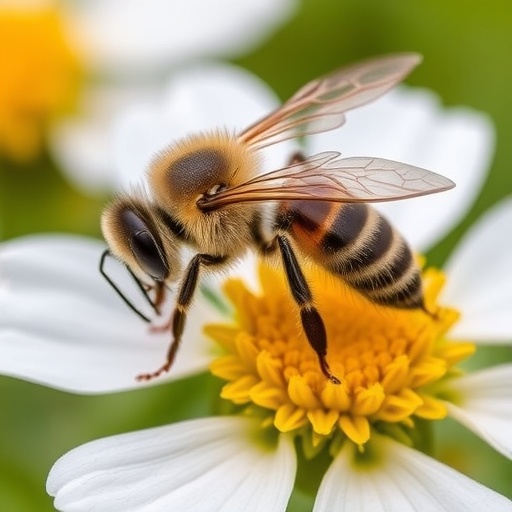In recent ecological research, a keen focus has been placed on pollinator dynamics, particularly among various species of bees. One of the most intriguing studies to emerge is led by a collaborative group of scientists exploring the impact of floral characteristics on the visitation habits of the tropical stingless bee species, Tetragonula iridipennis. This species has been identified as a crucial player in pollination within tropical ecosystems, but the nuances of its interactions with floral traits have remained largely unexplored until now.
The researchers conducted a detailed examination of how specific floral traits, such as color, shape, aroma, and nectar production, influence the visitation patterns of these miniature bees. This work is critical not only for understanding the fundamental behaviors of Tetragonula iridipennis but also for the broader implications it holds for pollinator ecology and the sustainability of plant-pollinator relationships in tropical regions. The team hypothesized that variations in flower morphology and chemistry would significantly alter bee attraction and visitation frequency.
Through rigorous field experiments and controlled observations, the study revealed compelling evidence that certain floral traits attract stingless bees more effectively than others. The researchers noted that vibrant colors, particularly in the spectrum visible to bees, play a pivotal role in drawing these pollinators toward particular flowers. They emphasized how the visual acuity of Tetragonula iridipennis allows them to discern these variations, which is critical for their foraging success.
In addition to color, the shape of flowers was also found to play a significant role in the visitation rates of the bees. Specifically, the study addressed how the structural traits of flowers, such as depth and petal arrangement, affect a bee’s ability to access nectar and pollen. The findings suggested that flowers offering more accessible and rewarding structures are likely to receive higher rates of bee visitation. This aspect of floral morphology is crucial for understanding how different species adapt their reproductive strategies in response to their pollinators.
Additionally, the research highlighted the fascinating interplay of floral fragrance. Chemical compounds released by flowers can serve as a beacon for pollinators, signaling the presence of nectar and guiding them toward potential food sources. The study conducted by the authors documented the various volatile compounds released by different species of flowers and correlated these with visitation rates by Tetragonula iridipennis, revealing a complex relationship between scent and pollinator attraction.
The implications of this research extend beyond mere academic curiosity. By unraveling the specifics of how floral traits influence bee behavior, the study has profound implications for conservation efforts and agricultural practices. For instance, understanding which floral traits enhance bee attraction can inform the cultivation of crops and native plants that support pollinator populations, therefore ensuring the sustainability of ecosystems that depend on these crucial species.
Moreover, in the context of global environmental changes, such as habitat loss and climate change, insights from this research are imperative for developing strategies that promote biodiversity. Pollinators like Tetragonula iridipennis are pivotal in maintaining healthy ecosystems, and the knowledge gained from studies like this can assist in creating habitats that are more resilient to environmental pressures.
Another significant aspect of the study is its contribution to the understanding of pollination effectiveness. While visitation rates are important, they do not always translate directly to successful pollination. The research also examined the subsequent outcomes of bee visits in terms of pollen transfer efficiency and subsequent seed set, offering a comprehensive view of the impact of floral traits on reproductive success in plants.
As urban areas expand and natural habitats become fragmented, the relationship between floral traits and pollinator visitation will only grow more critical. Urban ecology increasingly emphasizes the need for integrating natural landscapes with human developments, and research like this provides a scientific foundation for creating urban environments that support diverse pollinator populations.
In summary, the research conducted by A.J. M., K.M. N., and S. Sreekumar provides valuable insights into the intricate dynamics of flower-pollinator interactions. It reinforces the idea that maintaining floral diversity in ecosystems is essential for supporting a variety of pollinator species, including Tetragonula iridipennis. Furthermore, it sheds light on the importance of preserving tropical biodiversity in the face of ongoing environmental changes.
In conclusion, the newly published research not only deepens our understanding of the influence of floral traits on pollinator behavior but also emphasizes the vital role these relationships play in the sustainability of ecosystems worldwide. As the connections between plants and pollinators become clearer, the call to action for conservation and responsible agricultural practices becomes more urgent. This study is an imperative step forward in the quest to balance human activity with the needs of the natural world, ensuring that the delicate dances between bees and flowers continue for generations to come.
Understanding Tetragonula iridipennis and its floral interactions provides a glimpse into the broader ecological interactions at play in our world’s ecosystems. As more research is undertaken in this field, the hope is to create a more harmonious relationship between human agricultural practices and the natural pollinators that underlie food production and environmental health.
Subject of Research: The influence of floral traits on visitation patterns in Tetragonula iridipennis.
Article Title: Influence of floral traits on visitation patterns in a miniature tropical stingless bee, Tetragonula iridipennis.
Article References:
M., A.J., N., K.M., Sreekumar, S. et al. Influence of floral traits on visitation patterns in a miniature tropical stingless bee, Tetragonula iridipennis.
Sci Nat 112, 44 (2025). https://doi.org/10.1007/s00114-025-01994-0
Image Credits: AI Generated
DOI: https://doi.org/10.1007/s00114-025-01994-0
Keywords: Pollination, Tetragonula iridipennis, floral traits, bee visitation, tropical ecosystems.
Tags: bee visitation patternsecological research on pollinatorsfloral color influence on beesfloral traits and bee attractionflower morphology effects on beesnectar production and bee visitsplant-pollinator relationshipspollinator dynamics in tropical regionsstingless bee pollinationsustainable pollinator ecologyTetragonula iridipennis behaviortropical ecosystems and pollination





